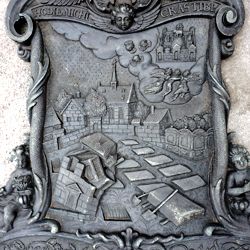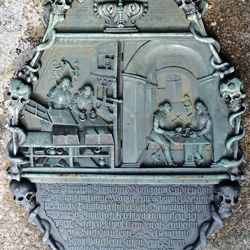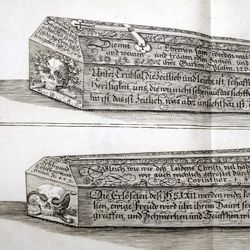Wolfgang (Wolff) d. Ä
Endter
publisher, book printer,
born Nürnberg, 04. Jul 1593
died Nürnberg, 17. May 1659
* 4th baptized. July 5, 1593 Nuremberg – † 17. buried May 21, 1659 Nuremberg, Grave No. P 122 in the Johannisfriedhof, epitaph dated 1631, still present. Son of George the Elder Ä. ∞ I) November 28, 1620 Maria Öder (* 10th, died May 11, 1597 – † 14th, born October 19, 1657), eight sons, two daughters, of which three sons and one daughter survive; II) August 18, 1658 Anna Regina Schubart (born April 28, 1622 – born August 4, 1661). Training as a printer and bookseller in his father's business. In 1612 he was a journeyman printer in Herborn, in the same year he received Katharina Dietrich's printing company, which he had acquired in 1602, from his father. In 1621 (not 1618) he took over his father's business alone. In 1619-55 he appeared as a printer, and in 1638-54 as a bookkeeper in the Ämterbüchlein. 1637-59 named. His typesetting shop was also set up for printing in Greek and Hebrew. The extensive printing activity with nine presses in three printing shops led to the establishment of a type foundry for our own needs. He had branches in Frankfurt and Leipzig. On his business trips he was attacked and plundered several times, and once captured and kidnapped. Like his father, he consciously maintained the calendar business, which was important at the time, and many well-known calendar makers worked for him. In 1629 he began printing Luther Bibles, for which he and his successors became one of the most important manufacturers in the 17th and 18th centuries. He also published devotional literature and school books, and he also had an electoral privilege for all school books in the Electorate of Saxony. His most important publishing work was the one commissioned by Duke Ernst III. Illustrated “Elector’s Bible” published by Weimar in 1641, also called the Weimar Bible, which reached its 14th and final edition in 1768. The Nuremberg House Bible, which he published in 1656, was distributed throughout Franconia and reached twenty editions by 1770. On June 17, 1651, Wolf Endter the Elder was born. Ä. by Emperor Ferdinand III. raised to the hereditary nobility, which was ignored by the Nuremberg patricianate; he did not use the title in Nuremberg. In 1651 he donated the grave E 24 for relatives of book printers, i.e. for journeymen of book printers, typesetters and type foundries in the Johannisfriedhof; the beautiful epitaph is still there today. In 1658 he donated a five-piece communion set to the Sebaldus Church with two large jugs, a chalice with a wafer plate and a wafer box. On June 21, 1623, he and his wife Maria bought a property on Nadlersgraben for 3,200 fl. On November 24, 1624, he acquired a property behind the Cloth House (Winklerstrasse 3) from Anna Maria Keltsch for 5,400 fl. and 50 fl. property (1,000 fl. mortgage) and 2,000 fl. gate (2nd mortgage). On August 25, 1645 he bought the property of Georg Endter the Elder. J. at the Wöhrdertürlein for 2,344 fl., which he sold again on April 8, 1652 for 3,400 fl. On May 14, 1650, he bought the house at Winklerstraße 5 for 8,000 fl., which was one of the most valuable town houses at the time. In 1630 he acquired the paper mill in Wendelstein for 825 fl., a short time later the paper mill in Hagenhausen, and he also owned paper mills in the Upper Palatinate, in Ravensburg and in Wangen in the Allgäu. His funeral poem, written by Simon Bornmeister, can be found in the StadtBN (Will II, 721.4°). Panzer recorded his portrait, and a baptismal shilling was minted in 1593. His widow married Zacharias Heinlein, lieutenant, on March 12, 1660. His sons Christoph and Paul inherited the printing company and business and ran the business until 1674, followed by Christoph's daughter Anna Maria until 1680. In 1680 Wolfgang Moritz, a grandson, and Johann Andreas, a nephew of Wolfgang d. Ä., the Endter companies again for a short time. In 1684 the businesses were separated again, Wolfgang Moritz took over the Dümler printing company and the type foundry, which were attached in 1652, and Johann Andreas continued to run the regular business. MuS: NUREMBERG, StadtB. –, GNM. –, LkAN. Lit.: ADB; NDB; Doppelmayr, 1730; Imhoff II, 1782, p. 737; Will, GL V, p. 285; Roth, 1802; Mid. a. d. StadtBN volume 4, issue 4, January 1956; Benzing, 1963; Sporhan-Krempel/Wohnhaas, 1973; Jamnitzer, 1985; Zahn, DI-N No. 4127; Grieb, book trade 2003. Exhibit: 1957/19; 1967/9; 1970/5; 1984/4; 1984/5; 2002/1 No. 91. (quoted from the Nuremberg Artists' Lexicon, edited by Manfred H. Grieb)
Period: 17th c.


